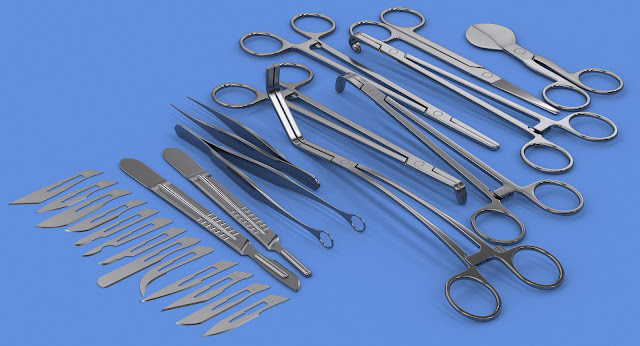Powered Surgical Instruments - The Future Of Minimally Invasive Surgery
 |
| Powered Surgical Instruments |
Introduction
Minimally invasive surgery (MIS) is progressively becoming more common for
various surgical procedures owing to benefits like reduced post-surgical pain,
quicker recovery times, and smaller scars. Powered surgical instruments have
introduced automation and precision in MIS, further advancing the scope and
outcomes of such procedures. This article discusses the major advancements in
powered surgical instruments and their potential to transform MIS.
Powered Shaving and Cutting Instruments
Powered shavers and cutters have allowed surgeons to perform more intricate
surgical maneuvers inside small incisions with ease and precision. Rotating
blades or burrs in these instruments help shave off tissue or make precise cuts
with controlled motions. This removes the limitations of manual instruments in
terms of control and consistency of motions inside the surgical field. Powered
shavers are commonly used in procedures like arthroscopy, hysterectomy, hernia
repair, etc. for tasks such as shaving cartilage, trimming sutures, and
dissecting tissues. Their automated and consistent motions minimize variation
between surgeons.
Staplers and Clip Applicators
Surgical staplers and clip applicators are powered instruments that help
surgeons perform tasks like cutting and closing tissues or vessels more quickly
during MIS. Powered staplers allow one-handed operation to securely staple and
divide tissues in precise locations. They minimize complications risk compared
to manual suturing inside small ports. Powered clip applicators also help
surgeons apply hemostasis clips swiftly to control bleeding during complex
surgeries. Their consistent positioning of clips reduces procedural time
compared to manual techniques. Staplers and clippers have considerably
increased the scope of advanced laparoscopic procedures.
Drill Systems for Fragmenting and Removing Tissue
Powered drill systems have become indispensable for tasks like bone drilling,
burring, and fragmentation inside the surgical field. They facilitate minimally
invasive procedures for joint replacement, tumor removal, fracture fixation,
etc. Controlled speed and precision of the drill bits help surgeons fragment
tissues like bone or tumors into smaller pieces suitable for removal through
narrow ports. Some advanced drills are also integrated with irrigation systems
to flush away fragments and prevent clogging. Drill systems optimize workflow
by automating repetitive and physically intensive drilling motions inside MIS.
Advancements in Robotic Surgery Systems
The continued progress in robotic surgical systems represents the future of
power-assisted surgery. Fully robotic procedures optimize dexterity, precision
and control beyond what is achievable manually. The da Vinci surgical system is
a pioneer in this field, helping perform complex MIS procedures like
prostatectomy, mitral valve repair, hysterectomy, etc. Robotic systems feature
high definition 3D cameras, wristed instruments responding to minimal hand
motions and tremor filtration for most precise dissection. Procedures using
robotics are associated with fewer complications, lower blood loss, shorter
hospital stays. While the high costs currently limit widespread adoption,
robotic surgery will transform many complex MIS specialties in the coming
decades.
Imaging Integration and AI-Assistance
Advanced Powered
Surgical Instruments are increasingly being integrated with
intraoperative imaging and artificial intelligence (AI) platforms. Ultrasound
probes, laparoscopes and instruments are being engineered with sensors to
facilitate real-time multiparametric visualization. These improve
image-guidance to precisely navigate instruments inside tissues. AI
technologies analyzing such imaging data also enable computer-aided detection
of key tissues intraoperatively. AI and machine learning algorithms can help
surgeons make evidence-based decisions, optimize instrument use based on
procedural progress and automate certain routine tasks to minimize fatigue. The
coming years will see deeper synergies between powered tools, imaging and AI in
MIS.
Conclusion
Powered surgical instruments have enabled the rise of minimally invasive
procedures with benefits of decreased trauma, faster recovery, and better
outcomes. Continued advancements integrating robotics, imaging and AI will help
automate complex maneuvers to maximize dexterity, precision and consistency
beyond human capabilities. This will expand the scope of MIS to address more
complex conditions and procedures. While initial costs pose limitations,
powered tools have established themselves as essential enablers of modern MIS.
Their future synergies with robotics and AI also holds promise to further
minimize invasiveness and optimize procedural efficiency.
Get
more insights, On Powered
Surgical Instruments



Comments
Post a Comment